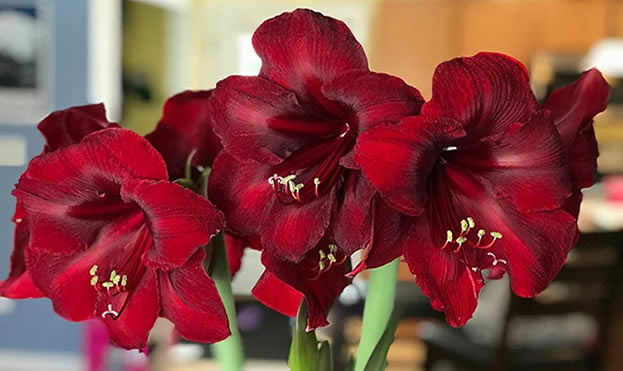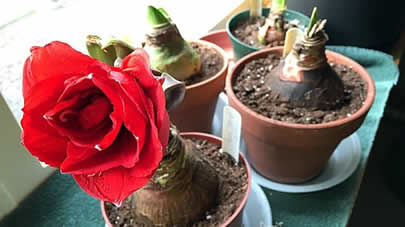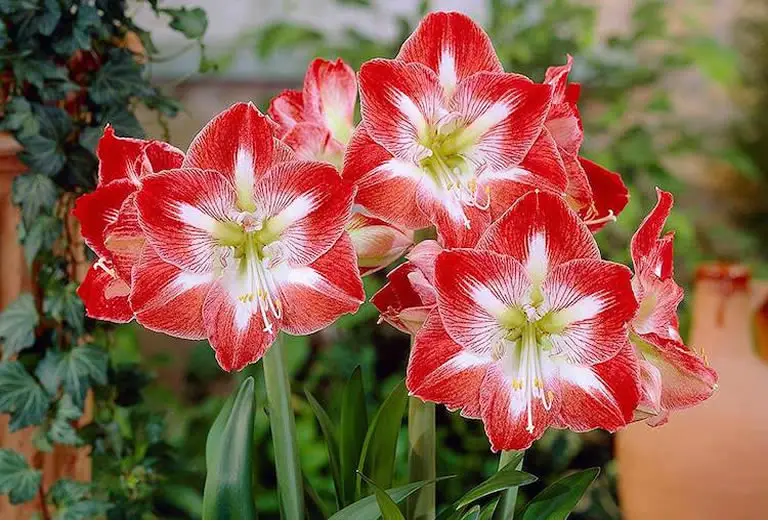Amaryllis is a perennial succulent that naturally blooms once per year in late winter or early spring. After blooming has completed amaryllis will not bloom again for another year. But there is a way to get your amaryllis to rebloom without having to wait 12 months and I am going to show you how to do it.
Table of Contents
- How to get amaryllis to rebloom & produce spectacular flowers
- Steps to get amaryllis to rebloom without stressing the plant
- A short period of dormancy is needed before reblooming can happen
- How to force an amaryllis bulb into dormancy before you get it to rebloom
- How to force the bulb out of dormancy to get the amaryllis to enter a new growth stage for reblooming
- When you should bring amaryllis out of dormancy – how long to let the bulb rest
- Once new growth has started, fertilizing your amaryllis at the right time will encourage reblooming
- How to get an amaryllis to rebloom: Quick overview
- A final word about forcing an amaryllis to rebloom
How often amaryllis usually bloom
As amaryllis is a perennial succulent that can live for many decades.
This plant can live so long that it is capable of outliving the person who initially planted it.
Many people mistakenly dispose of their amaryllis bulb after its first bloom because they do not know that it can rebloom.

But how many times can an amaryllis bloom?
Amaryllis is a perennial meaning it naturally blooms every year.
It will naturally bloom once in a 12 month period.
However, it is possible to force an amaryllis bulb to rebloom again within the same 12 month period to give you bi-yearly flowers.
There are specific steps that I use when I want a bi-yearly amaryllis bloom.
Because amaryllis is a perennial it will bloom once every year for many years with proper care.
As amaryllis bloom time can easily be manipulated, to force flowering in specific months, many plant lovers will keep two or more amaryllis and cultivate each plant to bloom during a different season instead of forcing one plant to rebloom.
I demonstrated how to do that in the article about amaryllis growth stages.
How to get amaryllis to rebloom & produce spectacular flowers
For those of you who have only one amaryllis plant and want to force it to rebloom I have included information below for doing just that.
However I urge you after you read that section, and before prepare you yourself to implement the steps for amaryllis reblooming, to take some time to consider if you really want to make your plant rebloom.
Wouldn’t be easier to simply grow an additional amaryllis with a different bloom time?

Not only is it easier to cultivate an amaryllis for a specific bloom time but it only requires you do it once.
Whereas, getting an amaryllis to rebloom every year requires you to take action on the plant every time you want it to rebloom.
Read this before you force amaryllis to rebloom
There is a great deal of interest in learning how to force amaryllis to rebloom but a question that is seldom asked is “should you force amaryllis to rebloom?”.
There is no evidence to suggest that forcing amaryllis to rebloom every year has any negative effect on the bulb.
However, I believe houseplants thrive best when we care for them in a way that follows their natural cycles and not when we work against them.
Amaryllis can live a very long time. There are amaryllis in the US that were planted in the 1950’s and they still bloom yearly to this day!
I do not know of any amaryllis plants, which were forced to rebloom every year, that are older than a few decades (though there may be some I do not know of).
I have however encountered some sickly amaryllis plants with poor blooms, and some that have no blooms at all, because the bulb had been overworked through force reblooming.
Therefore I rarely force amaryllis to rebloom, preferring instead to keep 3 plants that all bloom in different seasons for an almost constant amaryllis flower presence.
And, all of the plants are different species so I get to enjoy different colored flowers with each bloom.
Steps to get amaryllis to rebloom without stressing the plant
Ok, so the preaching is over, at least for this part of the article. 😉
So, without further ado here are step-by-step instructions for forcing your amaryllis plant to rebloom in a way that causes they least amount of stress to your plant.
A short period of dormancy is needed before reblooming can happen
The first step in the process of reblooming is to allow the amaryllis bulb to rest before forcing a rebloom.
There is a lot of advice online that suggests simply forcing the plant into another growth stage after its natural bloom, just before the bulb has time to go dormant.
I strongly discourage you from doing this.
Dormancy is essential for amaryllis and if you deny the bulb time to rest you will weaken your plant and end up with lackluster flowers or even no flowers at all.
Forced reblooming without allowing a short period of dormancy is one of the main reasons for amaryllis not blooming.
If you continue this “care” routine not only will you find you have a non-blooming plant but your plant will not live very long.

So, to ensure your amaryllis plant remains healthy it is necessary to allow for at least a short period of dormancy before you attempt to force the bulb to enter a new growth and blooming cycle.
Normally amaryllis will go dormant for 2 – 3 months. When you want to get your plant to rebloom you can leave the bulb dormant for 3 – 4 weeks, or force it into dormancy for that time period instead.
As I already stated it is possible to get the bulb to enter a new growth stage without allowing for dormancy but if you do that you are seriously damaging your plant.
How to force an amaryllis bulb into dormancy before you get it to rebloom
Amaryllis naturally go dormant once per year and will remain dormant for several months.
Dormancy usually occurs after blooming.
You know that an amaryllis is entering dormancy when the leaves start to turn yellow.
Normally you do not need to do anything with an amaryllis bulb after blooming.
The plant will enter dormancy naturally and remain at rest without you needing to move the bulb or even the plant pot.
However, when you want your amaryllis plant to rebloom you should force dormancy to occur directly after blooming has finished.
You start this process by removing all the leaves and stalks from the bulb.
Read this to ensure you cut the leaves correctly.
You can cut all the amaryllis leaves back and force dormancy while the plant is still flowering if you like to cut amaryllis flowers for vase use.
Or you can simply wait until blooming has finished and no more flowers are left.
After the foliage has been cut back you need to remove the bulb from it’s pot and store it in a dimly-lit, dry, cool place on newspaper or kitchen paper.
An ideal environmental temperature of between 55° – 59° F is best for ensuring the bulb goes, and remains, dormant.
Lower temperatures may damage the bulb while warmer temperatures may prevent the bulb from going dormant.
Allow it to rest for a few weeks.
How to force the bulb out of dormancy to get the amaryllis to enter a new growth stage for reblooming
The next step in the process of forced reblooming is waking the bulb from its slumber.
Once your amaryllis bulb has been allowed to rest for several weeks it is time to force it into a new growth cycle.
When you should bring amaryllis out of dormancy – how long to let the bulb rest
So when do you bring an amaryllis bulb out of dormancy?
Normally an amaryllis bulb will come out of dormancy naturally after a 2 – 3 month rest period.
The bulb will show signs of new leaf growth. If there is no new sprouts after 3 months you should force the bulb out of dormancy.
For forced reblooming, for 2 blooms in a 12 month period, I advise you to bring the bulb out of dormancy after 3 – 4 weeks.
Forcing an amaryllis bulb out of dormancy is easy.
When you want to force reblooming (or at any time when you want to force the bulb out of dormancy and into a new growth cycle) you should replant your amaryllis bulb in fresh potting soil.
I find that Miracle-Gro potting mix is an ideal growing medium for amaryllis as these plants are feeders.
The reason I use a potting mix is that it contains the right amount of nutrients for rapid and healthy foliage growth.

Amaryllis are also thirsty plants, especially for succulents.
The bulb has been starved of water for several weeks during dormancy.
Giving it water will help stimulate new growth.
Water the bulb generously but make sure you do not drench the soil – see our amaryllis watering guide.
A pot with sufficient drainage should ensure this does not happen.
Once new growth has started, fertilizing your amaryllis at the right time will encourage reblooming
In the initial stages of the new growth of the amaryllis plant there should be more than sufficient nutrients in the soil, if you have used a potting mix like the one I recommended.
However, to stimulate a new bloom and not just foliage growth I suggest you fertilize the plant every 2 – 3 weeks after repotting and then at 2 week intervals during its growth.
I use a fertilizer that has a 10-10-10 ratio of NPK (nitrogen, phosphorus, potassium), to feed indoor amaryllis as this type of fertilizer will give amaryllis everything it needs to thrive.
Having said that, any one of the good quality slow release succulent fertilizers available on the market these days will work well with amaryllis too.
How to get an amaryllis to rebloom: Quick overview
Below is a quick overview of the steps you need to follow to get an amaryllis to rebloom.
How to force amaryllis to rebloom in 5 simple steps:
- Cut back all the foliage from the plant until you are left with a bare bulb.
- Remove the bulb from the soil and store it in a cool, dry and dimly-lit place.
- Allow the bulb to rest for about 3 weeks.
- Force the bulb out of dormancy by repotting it and watering it.
- Fertilize the plant every 2 weeks during the new growth stage.
If you are trying to get an outdoor amaryllis to rebloom you can follow the same steps outlined above.
You may want to replant the bulb in a pot before putting it directly back into the yard soil though and only when you see clear signs of new foliage growth.
Be aware that forcing an outdoor plant to rebloom will only be effective in tropical and subtropical climates.
If you are one of our website visitors that hails from the UK you can also follow the same steps to get your amaryllis to rebloom.
UK readers may want to read our extensive guide to growing amaryllis in the UK first.
A final word about forcing an amaryllis to rebloom
As I have already mentioned in this article, and in other places on this website, I am not a big fan of forcing amaryllis to rebloom because it puts stress on the bulb.
Overworked bulbs produce inferior blooms and will, eventually, produce no blooms at all and perhaps even a dead plant.
It is much better to have 2 or more amaryllis plants and simply stagnate their bloom times.
It is possible to have constant amaryllis blooms year round if you have the room for several plants.
If you do decide to force your amaryllis to rebloom I suggest you do so sparingly.
At least every 3 years allow the bulb to rest completely, and come out of dormancy naturally, if you want to enjoy amaryllis flowers for years to come.

